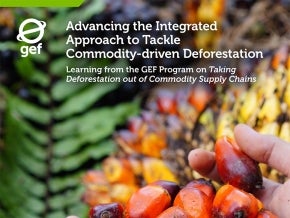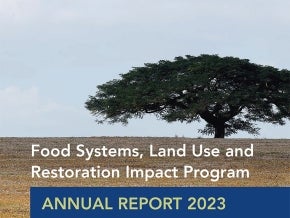
Urban areas can change the broken food system that causes ill-health and environmental degradation
Over half of the world’s 7.7 billion people live in towns and cities. By 2050, more than two thirds of them will do so. Materials, waste, emissions, knowledge and influence follow this population explosion.
Cities will increasingly hold sway over the way the global economy functions. They thus have the ability and responsibility to address major global challenges. And perhaps none is more pressing than our broken food system.
As in many other industries, the way we grow and process food is linear: take, make, waste. Priority has been given to repeated extraction and consumption, with little thought to the long-term picture.
Over decades of harvests, we have produced a food system that creates enormous waste and consumes vast quantities of non-renewable inputs. It requires chemical fertilisers, pesticides, excessive antibiotics and fossil fuels to grow and ship food around the world. It has enabled us to produce plentiful food, but is now costing us as individuals, and as a society.
We hear about health costs related to consumption, like malnutrition and obesity, but problems associated with production pose an equal threat to lives and livelihoods.
Analysis shows that, for every dollar spent on food, society pays two in health, environmental and economic costs: $5.7 trillion (£4.33 trillion) of this huge annual economic burden is due to how food is produced and how its by-products are managed.
Excessive use of fertilisers, and antibiotics in animal farming, together with poorly managed manure and human waste, could contribute to five million deaths a year by 2050 – twice the current toll from obesity, and four times the number who die on the roads.
This way of producing food also results in significant economic losses, environmental pollution and degradation – and contributes to climate change and damage to the global commons. It accounts, for example, for over 25 per cent of greenhouse gas emissions and 70 per cent of global freshwater demand.
Many of these problems are overlooked and under-reported – but they can be addressed with a system-wide approach. Since an estimated 80 per cent of all food will be destined for cities by 2050, they are crucial to sparking this.
As the world’s economic engines, cities have at their disposal a wealth of resources that could drive a positive transformation of the food system. That, in turn, could ripple into non-urban areas, all the way back to the farms on which our food is grown.
It could provide healthy and nutritious food for all, more diverse and resilient food supply chains – and an extraordinary economic opportunity.
The Ellen MacArthur Foundation's Cities and Circular Economy for Food report estimates that actions in cities could bring an enormous $2.7 trillion (£2 trillion) worth of benefits a year in 2050.
Health costs from pesticide use would decrease by $550 billion (£418 billion) and antimicrobial resistance, air pollution, water contamination, and food-borne diseases would also be greatly reduced.
Greenhouse gas emissions are expected to decrease by the equivalent of 4.3 billion tonnes of carbon dioxide, corresponding to taking one billion cars off the road permanently.
The report – part of the World Economic Forum's Platform for Accelerating the Circular Economy – adds that 15 million hectares of arable land (an area larger than England) can be spared from degradation, and 450 trillion litres of fresh water saved.
Cities can also unlock benefits worth $700 billion (£532 billion) by reducing edible food waste and recycling organic materials.
Our analysis reveals three main ambitions that cities can adopt to create a circular economy for food. First, they can encourage regenerative approaches to food production that ensure it is cultivated in a way that enhances rather than degrades the environment.
And they can source it locally where appropriate: they can greatly influence how it is grown, particularly by interacting with producers within 12 miles (20km) of their boundaries.
Second, cities can spark a shift to a fundamentally different food system that moves beyond simply reducing food waste to designing out the concept of “waste” altogether. There are many ways to turn inedible food waste into valuable products like organic fertilisers, fabrics, and energy.
By making the most of food in this way, cities can become hubs in a thriving economy for materials and products based on it.
Third, those involved in urban food systems can design and market healthier food products. From breakfast cereals to takeaway meals, much of what is now eaten has been designed in some way by food brands, retailers, restaurants, schools, hospitals, and other providers.
Having shaped our food preferences and habits, these can now help reorient them to support regenerative food systems.
Food designers can, for example, urgently innovate with new plant-based proteins that need fewer natural resources, like soil and water, than animal ones. They can also develop ingredients and recipes that ensure that food can be safely returned to the soil or turned into other useful products.
While these three ambitions are each important and perhaps obvious, harnessing the connections between them will be truly revolutionary. If food is designed from the outset to be part of a regenerative system, nutrients can be recycled over and over again.
Even uneaten food is never wasted, but put to valuable use in fertilisers or nutritious food products. This, in turn, supports regenerative farming, producing more food without chemical fertilisers and pesticides. Thus the system gets better and better over time.
If it is to match the scale of the challenge, and opportunity, this new approach will need to bring global systems change. It will require everyone involved in the food value chain, including farmers, packagers, retailers, consumers, and governments. It must connect successful projects in cities with the multinational businesses and networks that can bring them to meaningful scale.
Fertile conditions need to be created for this new system to emerge, including supportive policy, innovation, financial instruments, and communications to engage the wider public.
As environmental degradation and health damage increase, business as usual will only exacerbate growing divisions across societies – between urban and rural, the rich and the poor. But cities have the power to change food systems, making them more valuable to the world than ever before.
This piece was originally published for the GEF-Telegraph Partnership.


